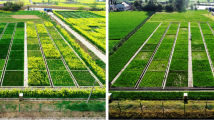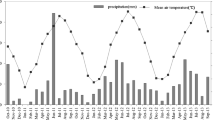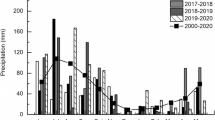Abstract
Proper rice straw management in paddy fields is necessary in order to sustain soil productivity and reduce greenhouse gas emissions. A field experiment was carried out from 2008 to 2011 in subtropical China: (1) to monitor rice yield, soil available nutrients, CH4, and N2O emissions and (2) to evaluate the effects of timing of rice straw incorporation and joint N application rate in a double rice cropping system. The total amount of rice straw from one cropping season was incorporated in winter (WS) or in spring (SS) and mineral N was jointly applied with rice straw incorporation at rates of 0, 30, and 60 % of the basal fertilization rate (N0B, N30B, and N60B) for the first rice crop. Soil water was naturally drained during the period of winter fallow (PWF) and controlled under intermittent irrigation during the period of first rice growth (PFR). Compared with SS, WS significantly (P < 0.05) increased the first rice yield only in the flooding year (2010), and increased the soil available K concentration after PWF and PFR in 2008–2009 and the hydrolysable N concentration after PWF in 2010–2011. Meanwhile, WS significantly decreased the total CH4 emission by about 12 % in 2009–2010 and 2010–2011, but increased the total N2O emission by 15–43 % particularly during PWF in all 3 years, resulting in a lower GWP in WS in the flooding year and no differences in the nonflooding years. Compared with N0B, joint N application (N60B and N30B) increased the soil hydrolysable N after PWF in all 3 years. Meanwhile, it decreased the total CH4 emissions by 21 % and increased the N2O emissions during PWF by 75–150 % in the nonflooding years, but the net GWP was lower in N60B than in N0B. The results suggested that the rice straw incorporation with joint N application in winter is more sustainable compared with the local practices such as rice straw incorporation in spring or open-field burning.



Similar content being viewed by others
Abbreviations
- WS, SS :
-
Rice straw incorporation in winter and spring, respectively
- N0B, N30B,N60B :
-
0, 30, and 60 % of the basal fertilization rate, respectively
- PWF, PFR :
-
The period of winter fallow and the period of first rice growth, respectively
- CH4 :
-
Methane
- N2O:
-
Nitrous oxide
References
Aerts R, Ludwig F (1997) Water-table changes and nutritional status affect trace gas emissions from laboratory columns of peatland soils. Soil Biol Biochem 29:1691–1698
Aerts R, Toet S (1997) Nutritional controls of carbon dioxide and methane emission from Carex-dominated peat soils. Soil Biol Biochem 29:1683–1690
Akiyama H, Yagi K, Yan X (2005) Direct N2O emissions from rice paddy fields: summary of available data. Global Biogeochem Cy 19:GB1005. doi:10.1029/2004GB002378
Aulakh MS, Doran JW, Walter DT, Mosier AR, Francis DD (1991) Crop residue type and placement effects on denitrification and mineralization. Soil Sci Soc Am J 55:1020–1025
Aulakh MS, Khera TS, Doran JW, Bronson KF (2001) Denitrification, N2O and CO2 fluxes in rice–wheat cropping system as affected by crop residues, fertilizer N and legume green manure. Biol Fertil Soils 34:375–389
Bird JA, Horwath WR, Eagle AJ, van Kessel C (2001) Immobilization of fertilizer nitrogen in rice: effects of straw management practices. Soil Sci Soc Am J 65:1143–1152
Bouman BAM, Tuong TP (2001) Field water management to save water and increase its productivity in irrigated lowland rice. Agr Water Manag 49:11–30
Bouwman AF, Boumans LJM, Batjes NH (2002) Emissions of N2O and NO from fertilized fields: summary of available measurement data. Global Biogeochem Cy 16:1058–1070
Bronson KF, Neue HU, Singh U, Abao EB (1997) Automated chamber measurements of methane and nitrous oxide flux in a flooded rice soil: I. Residue, nitrogen and water management. Soil Sci Soc Am J 61:981–987
Cai ZC (1997) A category for estimate of CH4 emission from rice paddy fields in China. Nutr Cycl Agroecosys 49:171–179
Cai ZC, Shan XH, Xu H (2007) Effects of nitrogen fertilization on CH4 emissions from rice fields. Soil Sci Plant Nutr 53:353–361
Chareonsilp N, Buddhaboon C, Promnart P, Wassmann R, Lantin RS (2000) Methane emission from deepwater rice fields in Thailand. Nutr Cycl Agroecosys 58:121–130
Conrad R, Klose M, Claus P (2002) Pathway of CH4 formation in anoxic rice field soil and rice roots determined by C-13-stable isotope fractionation. Chemosphere 47:797–806
Denier van der Gon HAC, Neue HU (1995) Influence of organic matter incorporation on the methane emission from a wetland rice field. Global Biogeochem Cy 9:11–22
Devêvre OC, Horwáth WR (2000) Decomposition of rice straw and microbial carbon use efficiency under different soil temperatures and moistures. Soil Biol Biochem 32:1773–1785
Eagle AJ, Bird JA, Hill JE, Horwath WR, van Kessel C (2001) Nitrogen dynamics and fertilizer use efficiency in rice following straw incorporation and winter flooding. Agron J 93:1346–1354
Hao X, Chang C, Carefoot JM, Janzen HH, Ellert BH (2001) Nitrous oxide emissions from an irrigated soil as affected by fertilizer and straw management. Nutr Cycl Agroecosys 60:1–8
Harada N, Otsuka S, Nishiyama M, Matsumoto S (2005) Influences of indigenous phototrophs on methane emissions from a straw-amended paddy soil. Biol Fertil Soils 41:46–51
Hou AX, Wang ZP, Chen GX, Patrick WH (2000) Effects of organic and N fertilizers on methane production potential in a Chinese rice soil and its microbiological aspect. Nutr Cycl Agroecosys 58:333–338
Huang Y, Zou JW, Zheng XH, Wang YS, Xu XK (2004) Nitrous oxide emissions as influenced by amendment of plant residues with different C:N ratios. Soil Biol Biochem 36:973–981
IPCC (2007) Climate change 2007: the physical science basis. Contribution of working group I to the fourth assessment report of the intergovernmental panel on climate change. Cambridge University Press, Cambridge
IUSS Working Group WRB (2006) World Reference Base for Soil Resources 2006, 2nd edition. World Soil Resources Reports No 103, Rome
Jensen ES (1997) Nitrogen immobilization and mineralization during initial decomposition of 15 N-labelled pea and barley residues. Biol Fertil Soils 24:39–44
Jiao ZH, Hou AX, Shi Y, Huang GH, Wang YH, Chen X (2006) Water management influencing methane and nitrous oxide emissions from rice field in relation to soil redox and microbial community. Commun Soil Sci Plant 37:1889–1903
Khalil MI, Inubushi K (2007) Possibilities to reduce rice straw-induced global warming potential of a sandy paddy soil by combining hydrological manipulations and urea-N fertilizations. Soil Biol Biochem 39:2675–2681
Khalil MI, Rosenani AB, Van Cleemput O, Boeckx P, Shamshuddin J, Fauziah CI (2002) Nitrous oxide production from an ultisol of the humid tropics treated with different nitrogen sources and moisture regimes. Biol Fertil Soils 36:59–65
Krüger M, Frenzel P (2003) Effects of N-fertilization on CH4 oxidation and production, and consequences for CH4 emissions from microcosms and rice fields. Global Change Biol 9:773–784
Lennartz B, Horn R, Duttmann R, Gerke HH, Tippkötter R, Eickhorst T, Janssen I, Janssen M, Rüth B, Sander T, Shi X, Sumfleth K, Taubner H, Zhang B (2009) Ecological safe management of terraced rice paddy landscapes. Soil Till Res 102:179–192
Liang W, Shi Y, Zhang H, Yue J, Huang GH (2007) Greenhouse gas emissions from Northeast China rice fields in fallow season. Pedosphere 17:630–638
Lindau CW, Bollich PK, Delaune RD, Patrik WH, Law VJ (1991) Effect of urea fertilizer and environmental factors on methane emission from a Louisiana, USA rice field. Plant Soil 136:195–203
Liu SW, Qin YM, Zou JW, Liu QH (2010) Effects of water regime during rice-growing season on annual direct N2O emission in a paddy rice-winter wheat rotation system in southeast China. Sci Total Environ 408:906–913
Lu WF, Chen W, Buan BW, Guo WM, Lu Y, Lantin RS, Wassmann R, Neue HU (2000) Methane emissions and mitigation options in irrigated rice fields in southeast China. Nutr Cycl Agroecosys 58:65–73
Ma J, Ma ED, Xu H, Yagi K, Cai ZC (2009) Wheat straw management affects CH4 and N2O emissions from rice fields. Soil Biol Biochem 41:1022–1028
McKenney DJ, Wang SW, Drury CF, Findlay WI (1993) Denitrification and mineralization in soil amended with legume, grass, and corn residues. Soil Sci Soc Am J 57:1013–1020
Meng L, Hess PGM, Mahowald NM, Yavitt JB, Riley WJ, Subin ZM, Lawrence DM, Swenson SC, Jauhiainen J, Fuka DR (2012) Sensitivity of wetland methane emissions to model assumptions: application and model testing against site observations. Biogeosciences 9:2793–2819
Minamikawa K, Sakai K, Hayashi H (2005) The effects of ammonium sulfate application on methane emission and soil carbon content of a paddy field in Japan. Agr Ecosyst Environ 107:371–379
Nguyen BC, Putaud JP, Mihalopoulos N, Bonsang B (1994) CH4 and CO emissions from rice straw burning in South East Asia. Environ Monit Assess 31:131–137
Pathak H, Singh R, Bhatia A, Jain N (2006) Recycling of rice straw to improve wheat yield and soil fertility and reduce atmospheric pollution. Paddy Water Environ 4:111–117
Qin JT, Hu F, Zhang B, Wei ZG, Li HX (2006) Role of straw mulching in non-continuously flooded rice cultivation. Agr Water Manag 83:252–260
Qin Y, Liu S, Guo Y, Liu Q, Zou J (2010) Methane and nitrous oxide emissions from organic and conventional rice cropping systems in Southeast China. Biol Fertil Soils 46:825–834
Robertson GP, Grace PR (2004) Greenhouse gas fluxes in tropical and temperate agriculture: the need for a full-cost accounting of global warming potentials. Environ Dev Sustain 6:51–63
Sasada Y, Win KT, Nonaka R, Win AT, Toyota K, Motobayashi T, Hosomi M, Chen DJ, Jun L (2011) Methane and N2O emissions, nitrate concentrations of drainage water, and zinc and copper uptake by rice fertilized with anaerobically digested cattle or pig slurry. Biol Fertil Soils 47:949–956
Sass RL, Andrews JA, Ding AJ, Fisher FM (2002) Spatial and temporal variability in methane emissions from rice paddies: implications for assessing regional methane budgets. Nutr Cycl Agroecosys 64:3–7
Schimel J (2000) Global change: rice, microbes and methane. Nature 403:375–377
Shan YF, Cai ZC, Han Y, Johnson SE, Buresh RJ (2006) Accumulation of organic acids in relation to C:N ratios of straws and N application in flooded soil. Acta Pedologica Sinica 43:941–947
Shang QY, Yang XX, Gao CM, Wu PP, Liu JJ, Xu YC, Shen QR, Zou JW, Guo SW (2011) Net annual global warming potential and greenhouse gas intensity in Chinese double rice-cropping systems: a 3-year field measurement in long-term fertilizer experiments. Global Change Biol 17:2196–2210
Shelp ML, Beauchamp EG, Thurell GW (2000) Nitrous oxide emissions from soil amended with glucose, alfalfa, or corn residues. Commun Soil Sci Plant 31:877–892
Singurindy O, Molodovskaya M, Richards BK, Steenhuis TS (2009) Nitrous oxide emission at low temperatures from manure-amended soils under corn (Zea mays L.). Agr Ecosyst Environ 132:74–81
Sparks DL, Page AL, Helmke PA, Loeppert RH, Soltanpour PN, Tabatabai MA, Johnston CT, Sumner ME (1966) Methods of soil analysis. Part 3—chemical methods, 3rd edn. 1390 pp. ISBN 0-89118-825-8. SSSA and ASA, Madison
Tsuruta H, Kanda K, Hirose T (1997) Nitrous oxide emission from a rice paddy field in Japan. Nutr Cycl Agroecosys 49:51–58
Van Nguyen N, Ferrero A (2006) Meeting the challenge of global rice production. Paddy Water Environ 4:1–9
van Vliet PCJ, van der Stelt B, Rietberg PI, de Goede RGM (2007) Effects of organic matter content on earthworms and nitrogen mineralization in grassland soils. Eur J Soil Biol 43:222–S229
Verma TS, Bhagat RM (1992) Impact of rice straw management practices on yield, nitrogen uptake and soil properties in a wheat–rice rotation in northern India. Fertil Res 33:97–106
Wang MX, Shangguan XJ, Shen RX, Wassmann R, Seiler W (1993) Methane production, emission and possible control measures in the rice agriculture. Adv Atmos Sci 10:307–314
Wassmann R, Papen H, Rennenberg H (1993) Methane emission from rice paddies and possible mitigation strategies. Chemosphere 26:201–217
Wassmann R, Neue HU, Ladha JK, Aulakh MS (2004) Mitigation greenhouse gas emissions from rice-wheat cropping systems in Asia. Environ Dev Sustain 6:65–90
Wuebbles DJ, Hayhoe K (2002) Atmospheric methane and global change. Earth Sci Rev 57:177–210
Xing GX, Shi SL, Shen GY, Du LJ, Xiong ZQ (2002) Nitrous oxide emissions from paddy soil in three rice-based cropping systems in China. Nutr Cycl Agroecosys 64:135–143
Xiong Z, Xing G, Zhu Z (2007) Nitrous oxide and methane emissions as affected by water, soil and nitrogen. Pedosphere 17:146–155
Xu H, Cai ZC, Li XP, Tsuruta H (2000) Effect of antecedent soil water regime and rice straw application time on CH4 emission from rice cultivation. Aust J Soil Res 38:1–12
Xu YC, Shen QR, Li ML, Dittert K, Sattelmacher B (2004) Effect of soil water status and mulching on N2O and CH4 emission from lowland rice field in China. Biol Fertil Soils 39:215–217
Yagi K, Tsuruta H, Minami K (1997) Possible options for mitigating methane emission from rice cultivation. Nutr Cycl Agroecosys 49:213–220
Yan XY, Akimoto H, Ohara T (2003) Estimation of nitrous oxide, nitric oxide and ammonia emissions from croplands in East, Southeast and South Asia. Global Change Biol 9:1080–1096
Yan X, Akiyama H, Yagi K, Akimoto H (2009) Global estimations of the inventory and mitigation potential of methane emissions from rice cultivation conducted using the 2006 intergovernmental panel on climate change guidelines. Global Biogeochem Cy 23:GB2002. doi:10.1029/2008GB003299
Yu K, Chen G, Patrick WH Jr (2004) Reduction of global warming potential contribution from a rice field by irrigation, organic matter, and fertilizer management. Global Biogeochem Cy 18:GB3018. doi:10.1029/2004GB002251
Zhang GB, Zhang XY, Ma J, Xu H, Cai ZC (2011) Effect of drainage in the fallow season on reduction of CH4 production and emission from permanently flooded rice fields. Nutr Cycl Agroecosys 89:81–91
Zheng XH, Wang MX, Wang YS, Shen RX, Gou J, Li J, Jin JS, Li LT (2000) Impacts of soil moisture on nitrous oxide emission from croplands: a case study on rice-based agro-ecosystem in Southeast China. Chemosphere-Global Change Sci 2:207–224
Zheng X, Han S, Huang Y, Wang Y, Wang M (2004) Re-quantifying the emission factors based on field measurements and estimating the direct N2O emission from Chinese croplands. Global Biogeochem Cy 18:GB2018. doi:10.1029/2003GB002167
Zou J, Huang Y, Zong L, Zheng X, Wang Y (2004) Carbon dioxide, methane and nitrous oxide emissions from a rice-wheat rotation as affected by crop residue incorporation and temperature. Adv Atmos Sci 21:691–698
Zou JW, Huang Y, Jiang JY, Zheng XH, Sass RL (2005) A 3-year field measurement of methane and nitrous oxide emissions from rice paddies in China: effects of water regime, crop residue, and fertilizer application. Global Biogeochem Cy 19:GB2021. doi:10.1029/2004GB002401
Acknowledgments
This work was part of Special Fund for Agro-scientific Research in the Public Interest (201003016) and the Chinese Academy of Sciences Major Project of Knowledge Innovation Program (KSCX1-YW-09-08). Mr. Guilong Xia is appreciated for his careful management of the field experiments in his own land. Thanks are given to the editor (Paolo Nannipieri) of the paper and the other three anonymous reviewers for their comments, which are very helpful to improve the quality of the paper.
Author information
Authors and Affiliations
Corresponding authors
Rights and permissions
About this article
Cite this article
Zhang, B., Pang, C., Qin, J. et al. Rice straw incorporation in winter with fertilizer-N application improves soil fertility and reduces global warming potential from a double rice paddy field. Biol Fertil Soils 49, 1039–1052 (2013). https://doi.org/10.1007/s00374-013-0805-7
Received:
Revised:
Accepted:
Published:
Issue Date:
DOI: https://doi.org/10.1007/s00374-013-0805-7




